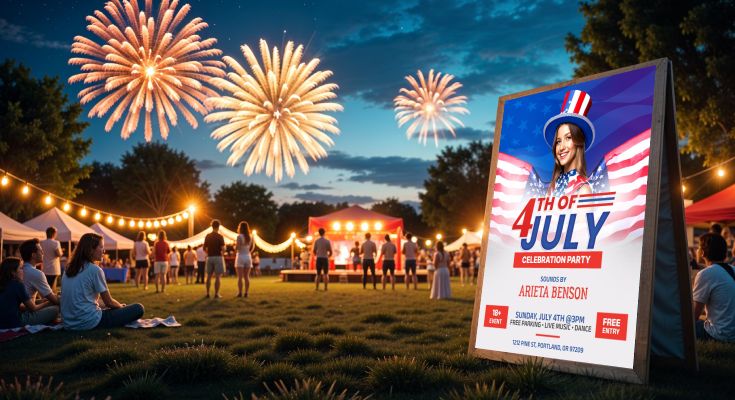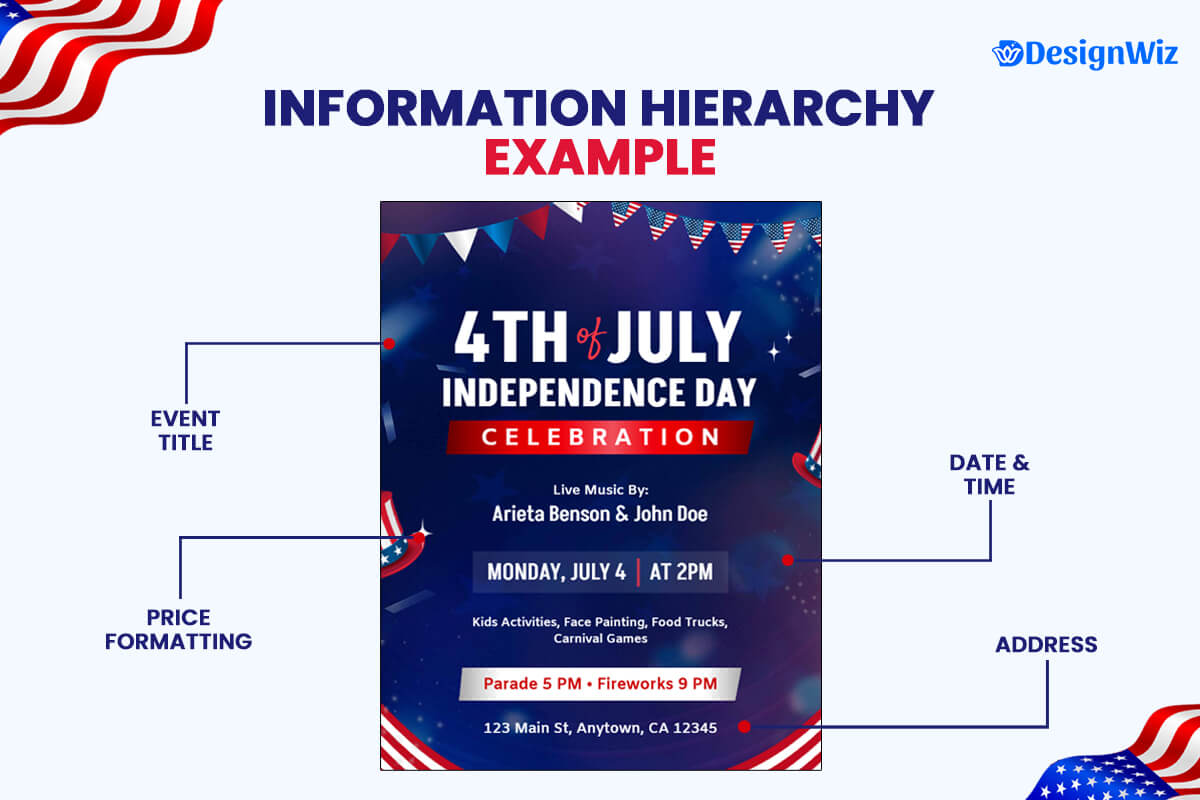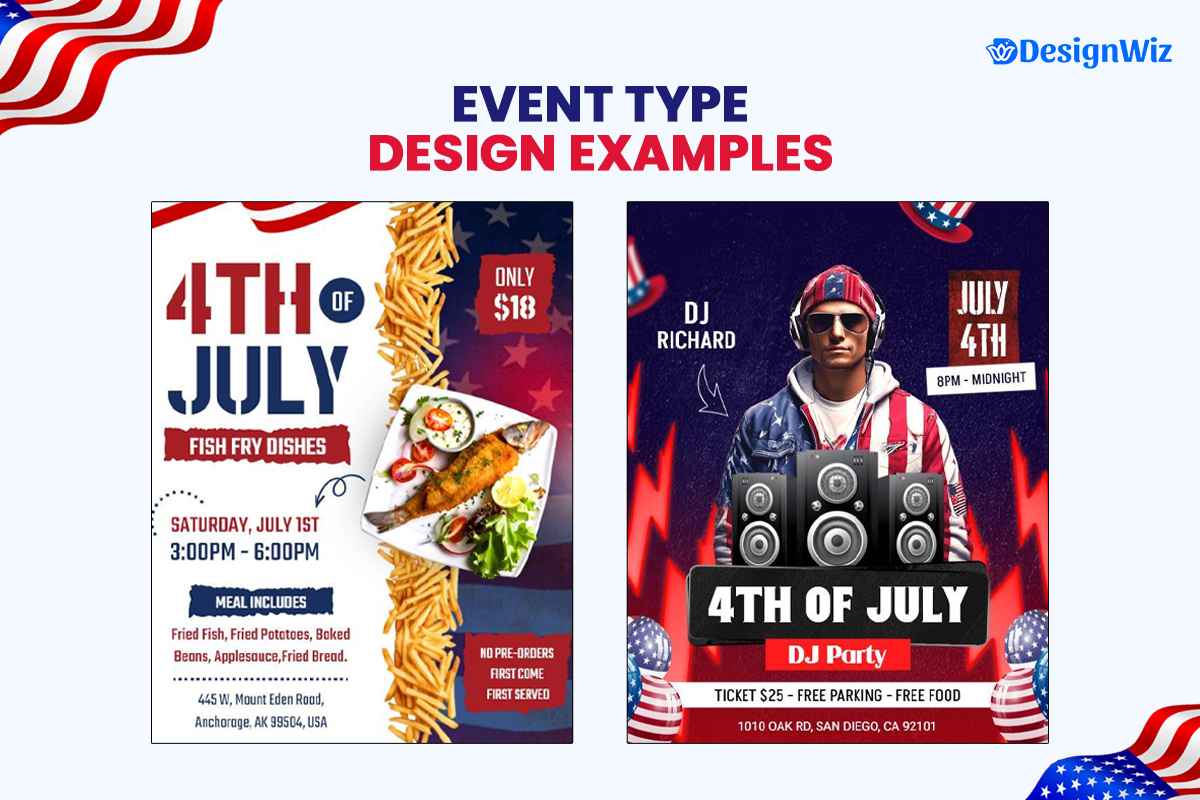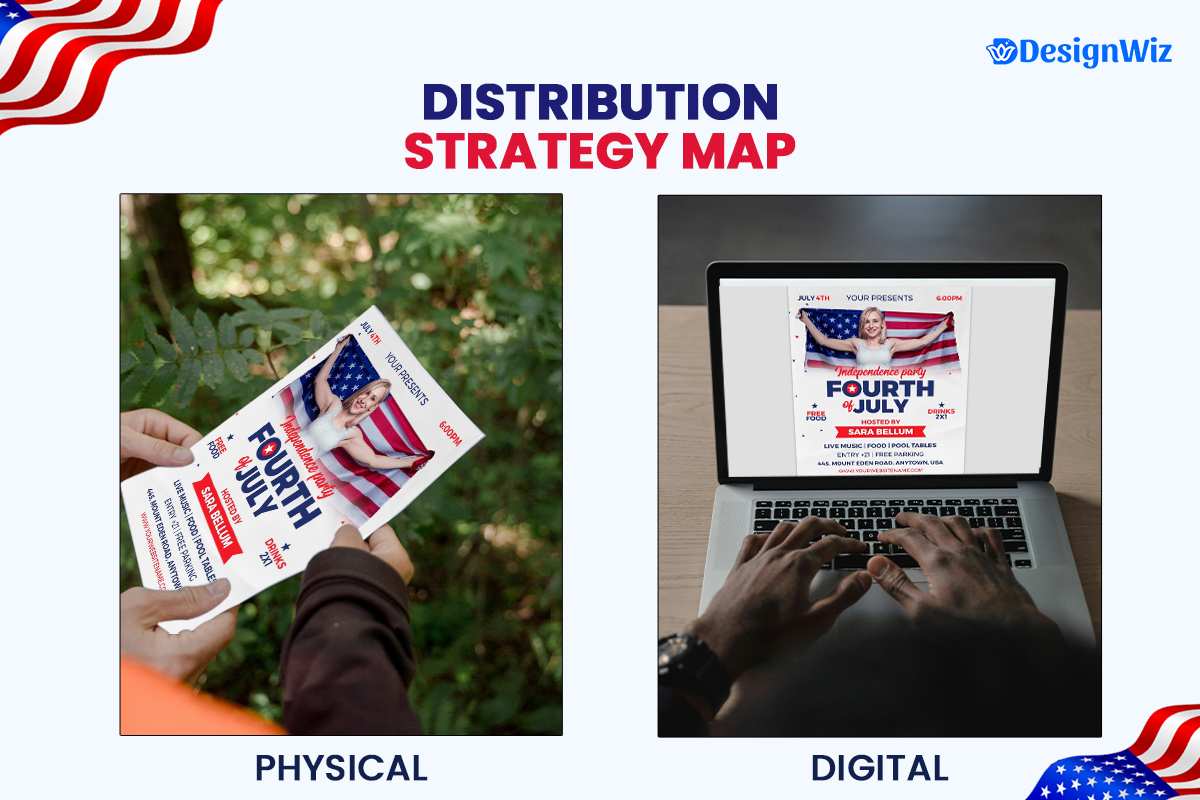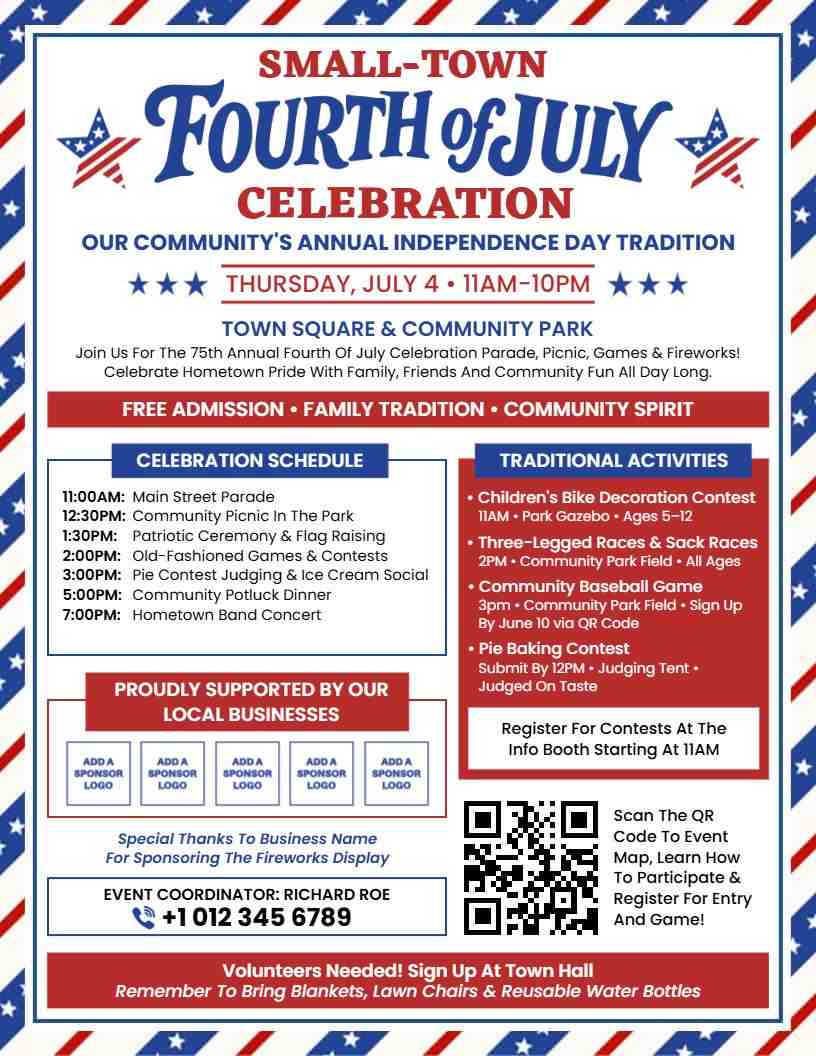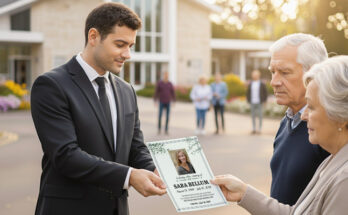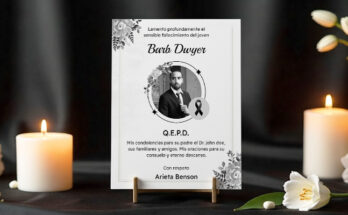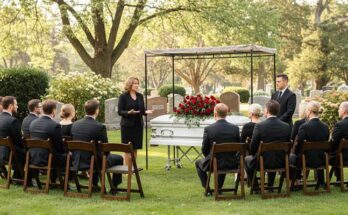Get ready-made flyer templates that rally neighbors—patriotic, festive, and perfect for local events.
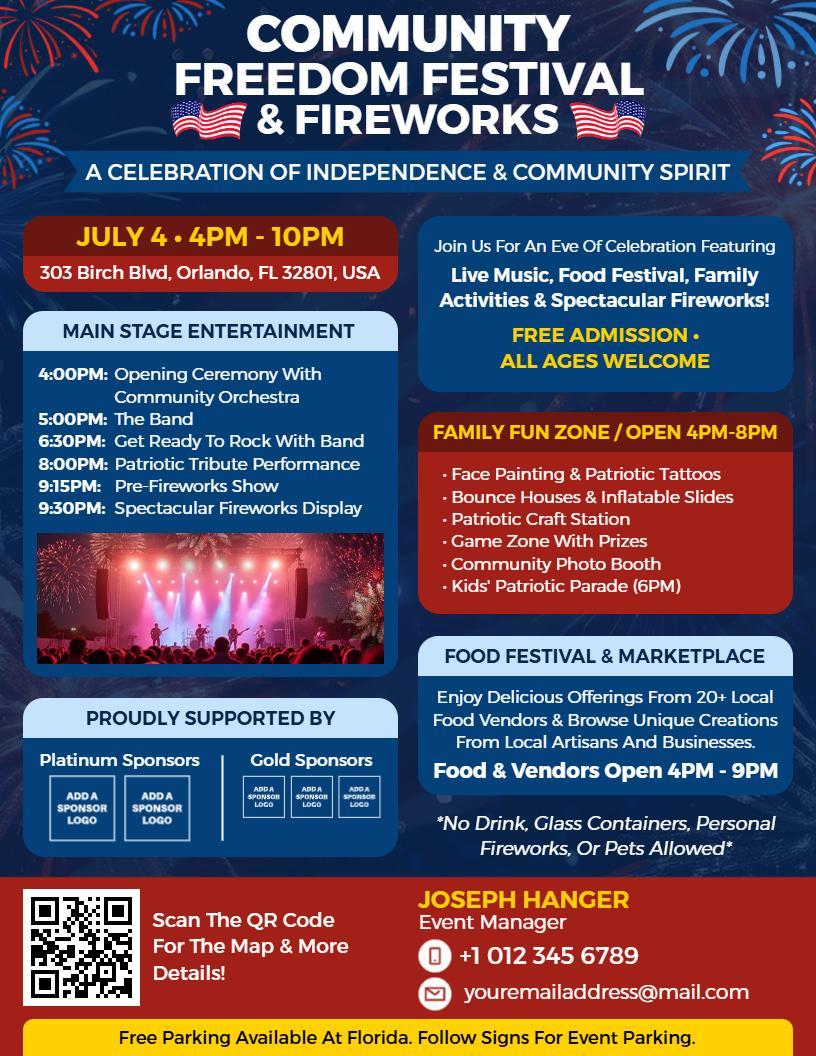
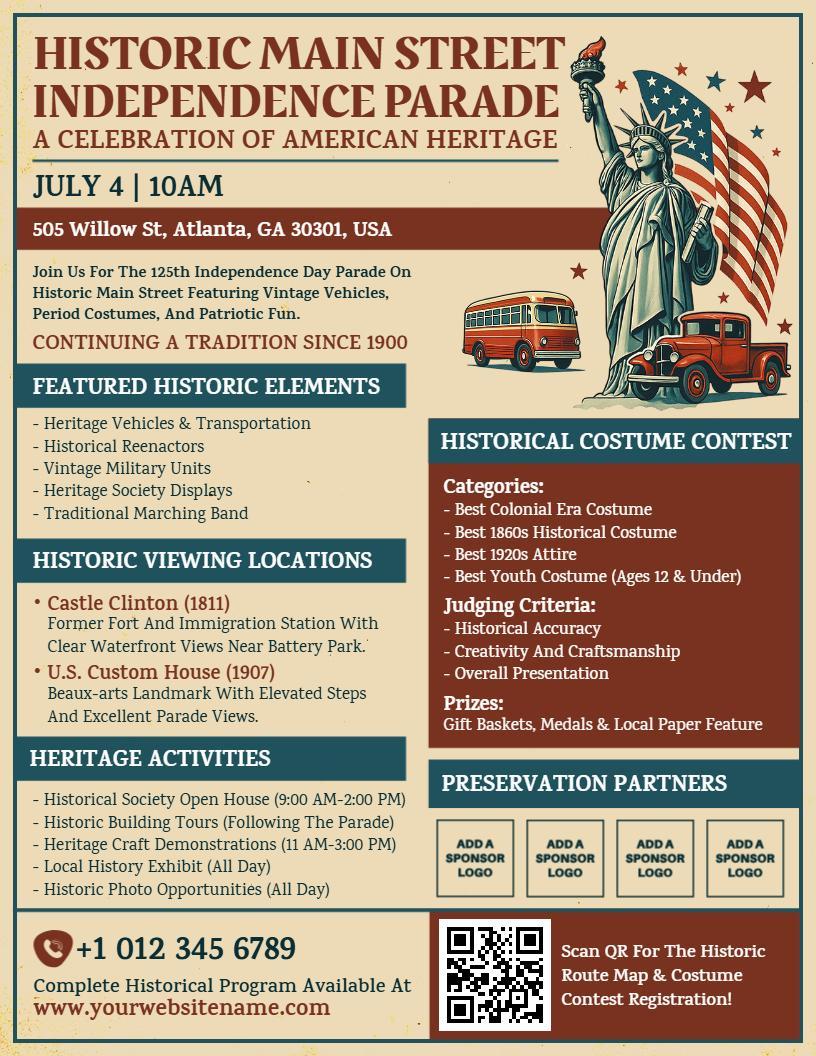
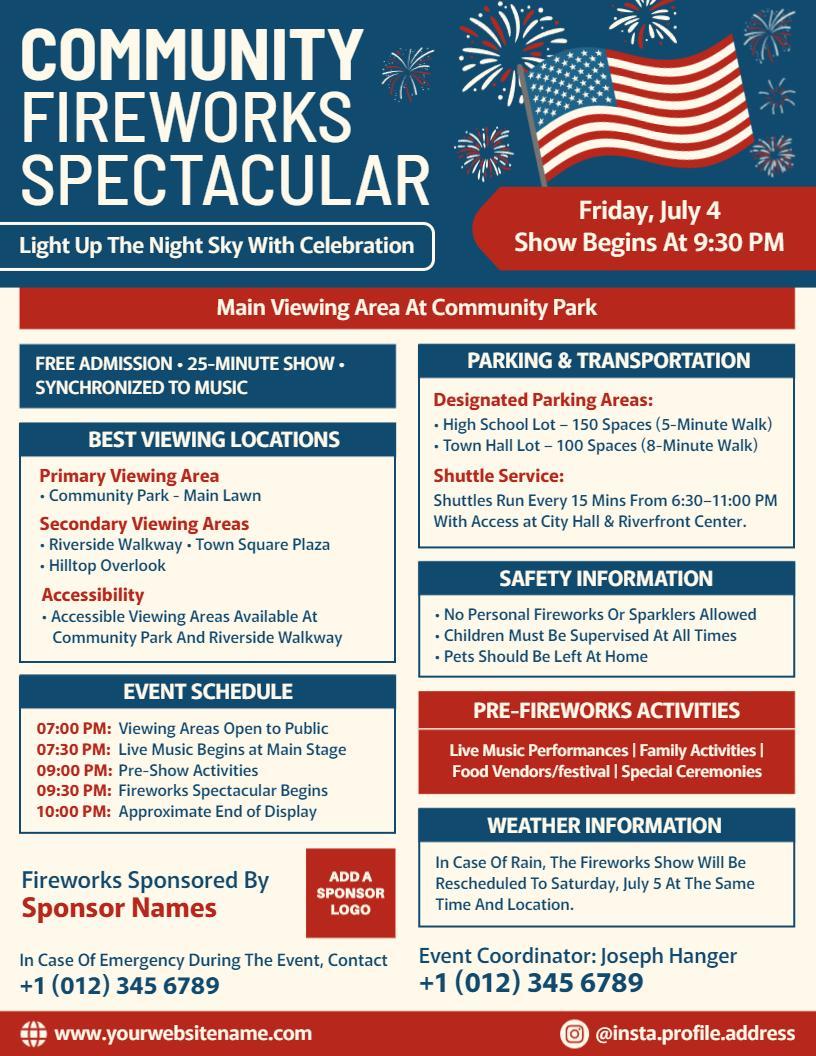
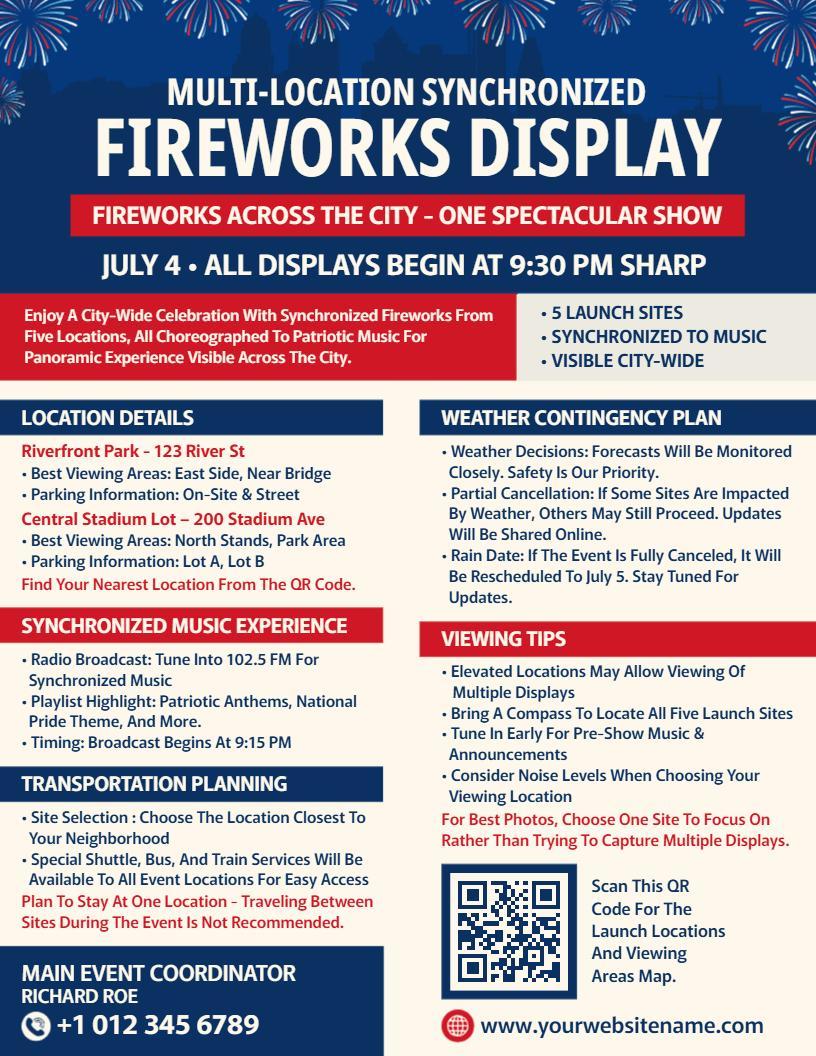
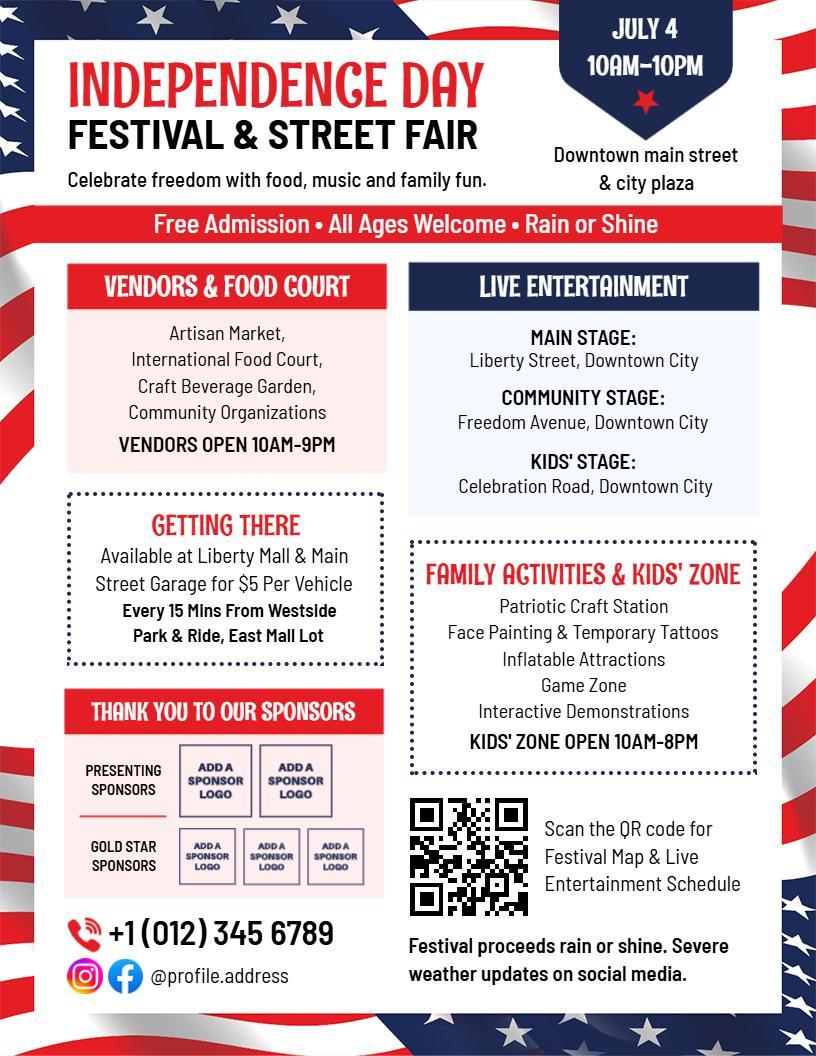
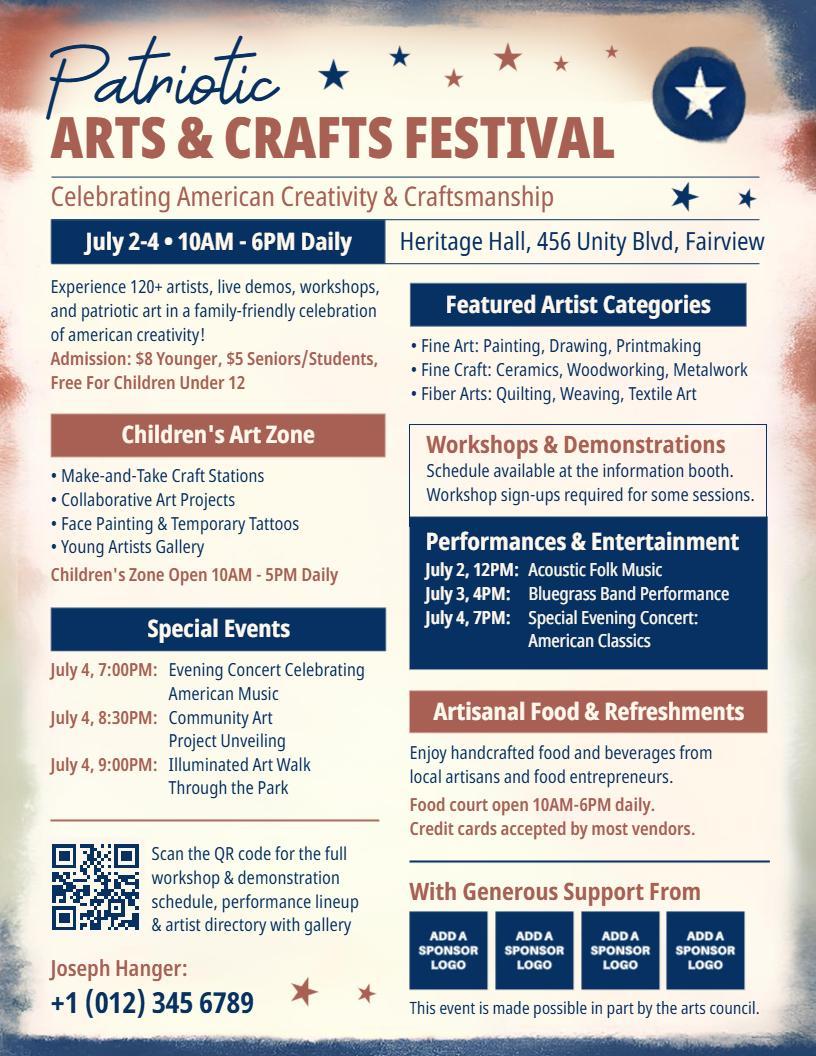
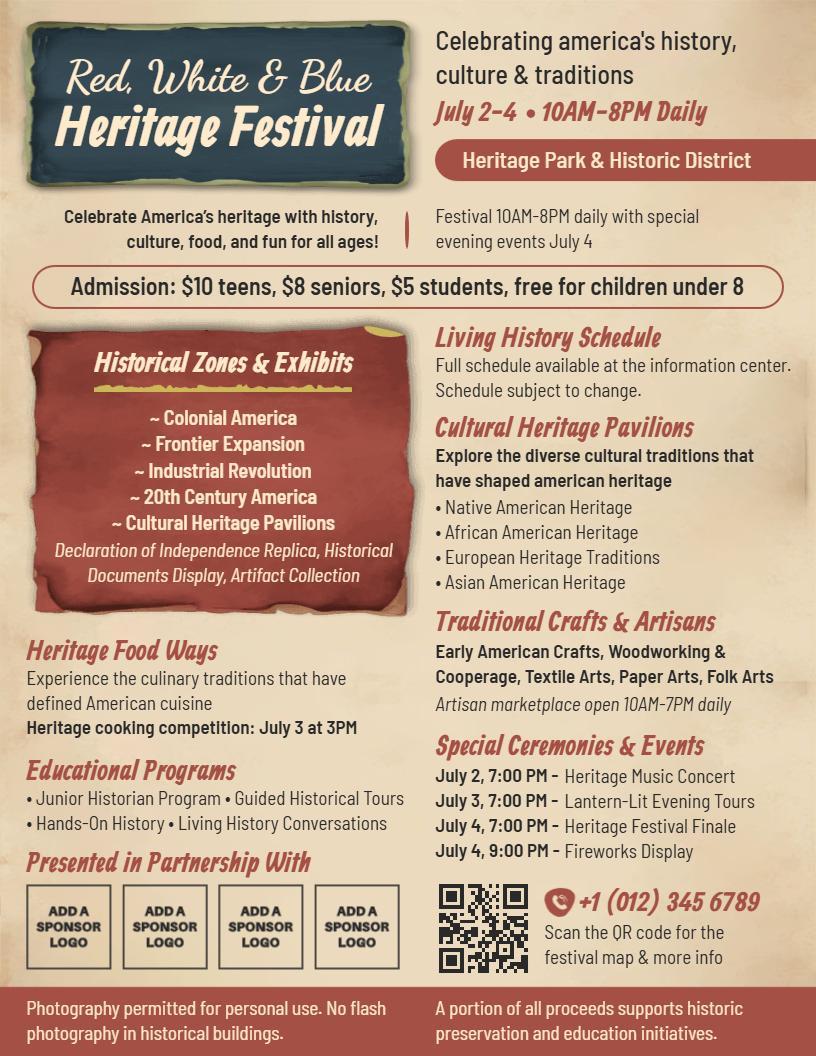
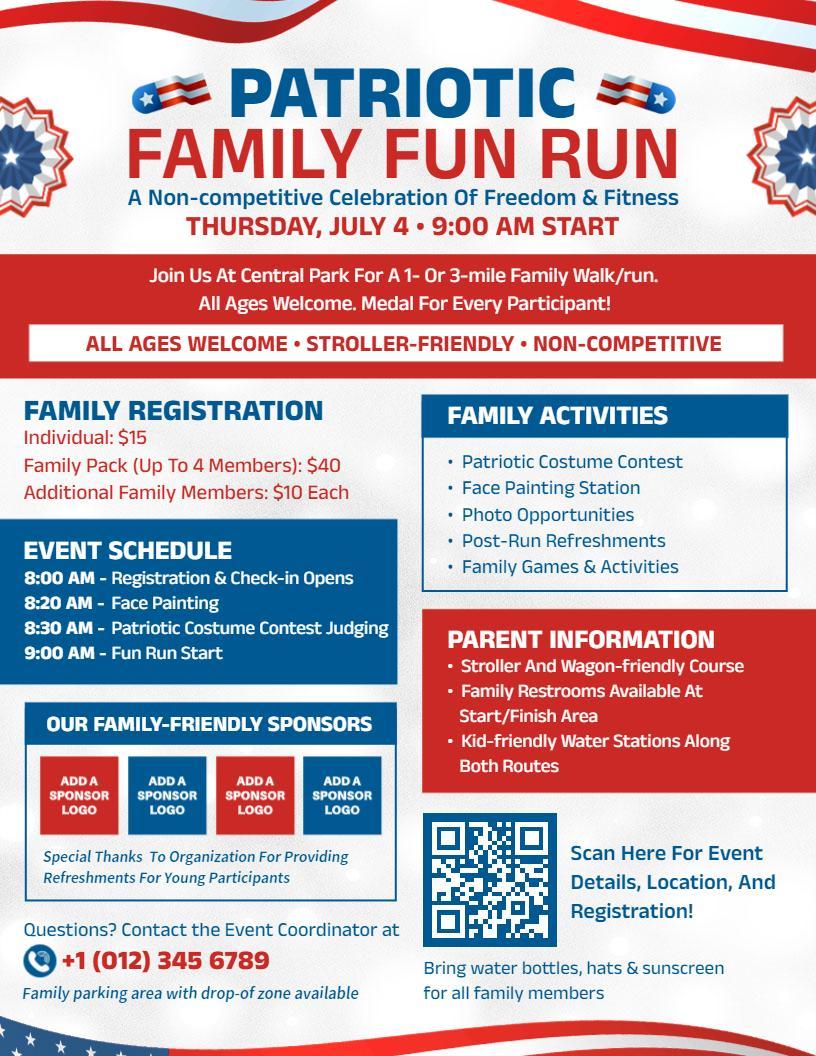
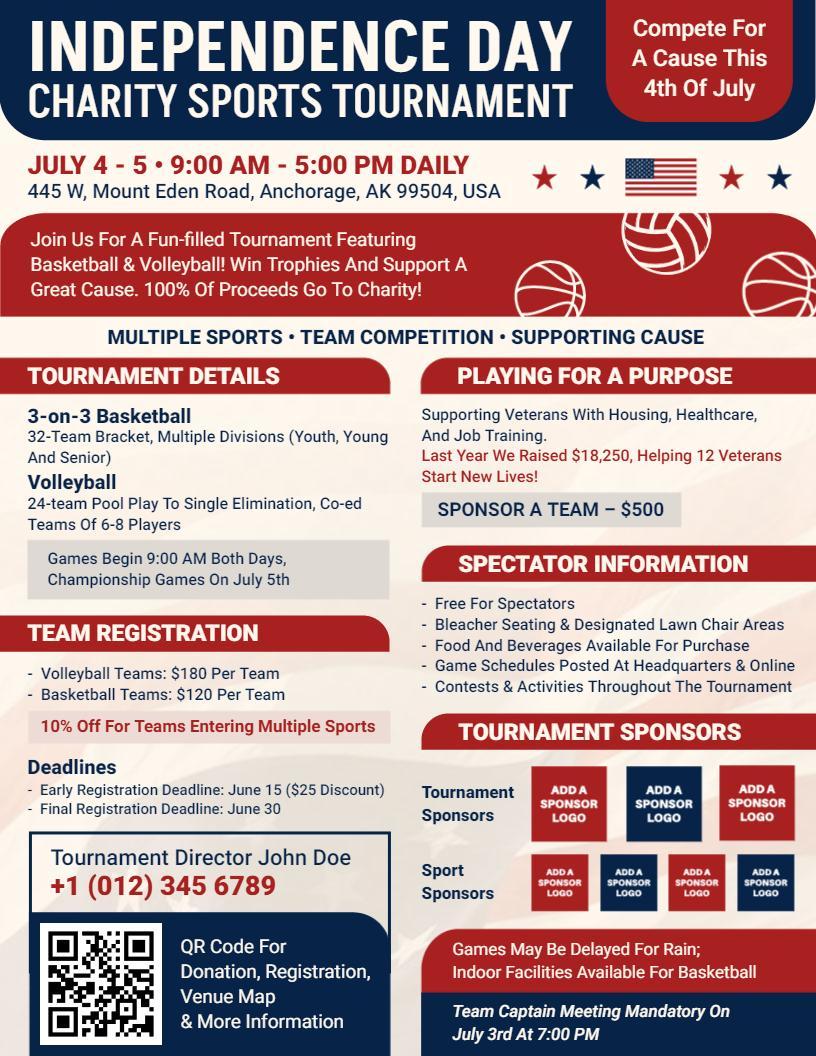
Creating compelling flyers for 4th of July community events requires specialized strategies that differ significantly from other industries. As a celebration of national pride and community spirit, 4th of July events tend to draw large local crowds, often seeing more participation than most other holidays except Christmas. Effective flyers communicate not just basic event information but also create excitement and community connection that drives attendance.
This guide provides event planners, community organizations, and municipalities with proven strategies for creating 4th of July event flyers that maximize attendance and participation. While our comprehensive 4th of July flyer guide covers general design principles, this resource focuses exclusively on community event applications.
What Information Must Be Included on 4th of July Community Event Flyers?
Community event flyers have unique information requirements that differ significantly from other industries like retail or restaurants. Exploring 4th of July retail flyer ideas shows how retail flyers focus more on seasonal promotions, unlike the local engagement seen in community flyers.
Based on the City of Santa Clara’s official 4th of July event information, effective community event flyers should clearly highlight event details such as the name, time, location, activities, safety guidelines, and contact information, which can boost public engagement by up to 45%, ensuring better attendance and smoother event management.1
Critical Information Hierarchy for Community Events
The most effective community event flyers present information in a specific order of importance:
- Event Name/Title (Primary focus – largest element)
- Date and Time (Including start and end times)
- Location (With address and landmarks)
- Brief Description (1-2 sentences on what to expect)
- Cost Information (Free, suggested donation, or ticket price)
- Special Features (Fireworks, performances, activities)
- Contact Information (For questions or special needs)
- Weather Contingency (Rain date or indoor options)
Information Density Balance
Community event flyers often need to include more details than typical marketing materials, making layout balance crucial. To get it right, explore industry specific 4th of July flyers that show how different sectors organize content without overwhelming the design.
| Information Level | Best For | Format Considerations |
|---|---|---|
| Comprehensive | Multi-activity events, all-day celebrations | 8.5″ x 11″ or larger, consider multi-panel designs |
| Focused | Single events, specific activities | 5.5″ x 8.5″, more image-focused design |
| Teaser | Building initial awareness | 4.25″ x 5.5″ or digital, with link to full details |
Family-Specific Information
For family-oriented 4th of July events, including specific details that help parents plan,, is crucial:
- Age-appropriate activities (with age ranges noted)
- Family facilities (restrooms, changing areas, stroller access)
- Food availability or picnic information
- Parking details with family access notes
- Special needs accessibility information
For general design principles that support effective information presentation, refer to our essential design elements guide for 4th of July flyers.
How Should You Organize Event Schedule Information on Flyers?
For community event with multiple activities, a schedule presentation can make or break your 4th of July flyers effectiveness. According to Northwestern University’s branding guidelines, effective flyers should present information in a simple and readable manner, avoiding visual clutter to ensure that event details are easily accessible to the audience.2
Effective Timeline Formats
For 4th of July events, several timeline formats prove most effective:
| Timeline Format | Best For | Visual Style |
|---|---|---|
| Chronological List | Simple sequence of events | Clean, vertical list with times on left, activities on right |
| Hour-by-Hour Grid | Complex, multi-location events | Table format with time blocks and location columns |
| Visual Timeline | Highlighting key moments | Graphical representation with icons for major activities |
| Activity Zones | Multiple simultaneous activities | Map-based with activity listings for each area |
Time Formatting Best Practices
How you present time information significantly impacts comprehension:
- Use consistent formatting throughout (12-hour or 24-hour format)
- Include am/pm designations (or indicate 24-hour format)
- State the day of the week alongside the date for multi-day events
- Highlight headliner events or key moments with visual emphasis
- Note the duration for activities when relevant
Activity Descriptions
For activities that may be unfamiliar to attendees, brief descriptions are essential:
- Keep descriptions to 8-12 words maximum
- Focus on participant experience rather than technical details
- Include age appropriateness when relevant
- Note any special requirements (tickets, registration, materials)
- Use active, engaging language that conveys excitement
What Map and Location Elements Improve Event Attendance?
To improve event attendance, especially for first-time attendees, it’s crucial to provide clear location details. Including a detailed map with entry points, parking areas, and key activity zones can significantly boost attendance. This is particularly important for events in unfamiliar venues like parks or locations without street addresses. For events with multiple locations, a map is essential for easy navigation and better planning.
Effective Map Integration
Unlike marketing materials for fixed-location businesses, community event flyers benefit significantly from map integration:
- Simple Location Maps: For single-venue events, showing major cross streets and landmarks
- Complex Event Maps: For multi-location events, showing activity zones and facilities
- Parking/Transportation Maps: Highlighting available parking areas, public transportation, and access routes
- Viewing Area Maps: For fireworks or parades, showing prime viewing locations
Map Design Best Practices
Effective event maps balance detail with clarity:
- Simplify to the essential elements only
- Use color coding for different zones or activities
- Include recognizable landmarks as orientation points
- Mark important facilities (restrooms, first aid, information)
- Add a simple compass or north indicator
- Indicate entry/exit points clearly
- Use consistent icon styles for different elements
By following these map design best practices, you ensure attendees can easily navigate your event, enhancing their experience and increasing overall attendance. A well-designed map can make all the difference in helping guests feel confident and prepared.
Address Presentation
How you present address information matters significantly:
- Include full street address with zip code
- Add neighborhood or district name for context
- Reference well-known nearby landmarks
- Provide GPS coordinates for rural locations
- Include “Located in [Park/Venue Name]” for specific areas within larger locations
Digital mapping integration also improves response:
- Add QR codes linking to Google Maps directions
- Include short URLs for online maps
- Mention if searchable on common map applications
Before diving into distribution strategies, it’s essential to get clear on the basics. This Event Information Checklist Generator helps you define the type of event you’re planning whether it’s a festival, concert, or ceremony, so you can apply the right tactics moving forward.
Plan your 4th of July event with ease
Plan your 4th of July event with ease
Plan your 4th of July event with ease
Plan your 4th of July event with ease
Plan your 4th of July event with ease
How Can You Design Flyers for Different Types of 4th of July Community Event?
Different 4th of July event types require specialized design approaches to effectively communicate their unique aspects. Tailoring the design to match the specific type of event can significantly boost interest, with custom designs making the event more appealing and engaging for attendees.
For example, church and nonprofit 4th of July flyers often require a more community-focused and heartfelt tone. Meanwhile, business promotions might prioritize clean layouts with strong call-to-action phrases, and concerts or festivals may lean into vibrant colors and high-energy visuals.
Parades and Processions
Parade flyers have unique requirements:
- Essential Elements: Route map, start/end times, viewing areas, participation information
- Visual Focus: Motion elements, directional graphics, and sequential imagery
- Information Priority: Route details, timing, and special participants/performances
- Distribution Strategy: Target locations along the route and community gathering spots
- Unique Needs: Participation instructions if community involvement is invited
Fireworks Displays
Fireworks display announcements benefit from:
- Essential Elements: Viewing locations, start time, rain date, parking information
- Visual Focus: Dramatic sky imagery, nighttime photography, and illuminated landscapes
- Information Priority: Best viewing areas, timing, weather contingencies
- Distribution Strategy: Wide community distribution starting 2-3 weeks before the event
- Unique Needs: Safety information, what to bring, and any restrictions
Community Festivals and Fairs
Festival and fair flyers should include:
- Essential Elements: Activity list, entertainment schedule, vendor information, admission details
- Visual Focus: Activity imagery, diverse attendance photos, and featured attractions
- Information Priority: Activities, food options, entertainment schedule
- Distribution Strategy: Family-focused locations, schools, and community centers
- Unique Needs: Activity zone maps, age-appropriate information, food/vendor highlights
Patriotic Ceremonies
Ceremonies and official observations require:
- Essential Elements: Program details, speakers, patriotic elements, historical significance
- Visual Focus: Dignified imagery, historical elements, and formal presentation
- Information Priority: Timing, program details, meaning/significance
- Distribution Strategy: Community organizations, veterans groups, local government
- Unique Needs: Seating information, protocol details, historical context
Family-Focused Events
Family event flyers should emphasize:
- Essential Elements: Age-appropriate activities, amenities, timing, and cost information
- Visual Focus: Families enjoying activities, kids engaged, multi-generational imagery
- Information Priority: Child-friendly details, timing, facilities available
- Distribution Strategy: Schools, family-oriented businesses, community centers
- Unique Needs: Clear indication of age-appropriateness, family facilities information
What Sponsor Recognition Strategies Work Best on Event Flyers?
To encourage sponsor renewal, give clear and prominent recognition on event flyers. Use a dedicated section with logos sized by contribution level to highlight their support. This helps sponsors feel valued and strengthens future partnerships.
Sponsor Hierarchy Implementation
Effective sponsor recognition follows a clear hierarchy based on contribution level:
| Sponsor Level | Recognition Approach | Size Guidelines | Placement |
|---|---|---|---|
| Title/Presenting | Largest logos, “Presented by” designation | 15-20% of the sponsor area | Top of the sponsor section |
| Gold/Major | Prominent logos in the primary sponsor area | 10-15% of the sponsor area | Upper sponsor section |
| Silver/Supporting | Medium logos in the main sponsor area | 5-8% of the sponsor area | Middle sponsor section |
| Bronze/Contributing | Smaller logos or name listing | 3-5% of the sponsor area | Lower sponsor section |
| In-Kind | Name listing in the supporting section | Text-only often sufficient | Supporting section |
Visual Integration Without Clutter
The challenge with sponsor recognition is maintaining design quality while fulfilling obligations:
- Use a distinct “Sponsor Section” with a clear border or background
- Create visual harmony by converting all logos to black, white, or a consistent color palette
- Maintain adequate white space between logos (minimum 50% of logo width)
- Consider a separate “Thank You to Our Sponsors” sidebar or footer
- Use QR codes linking to complete sponsor listings for events with many supporters
Municipal and Government Recognition
For official community events, government entities often require specific recognition:
- Official seals and logos may have usage requirements (size, clearance, color)
- Governmental departments may need to be listed in a specific order
- Grant funding often has explicit recognition requirements
- Public-private partnerships may have special designations
How Do You Balance Information Density with Visual Appeal?
To balance information density with visual appeal in community event flyers, focus on providing essential details without overwhelming the reader. Use clear, concise text and incorporate engaging visuals to draw attention. A well-structured layout with a mix of informative content and appealing design elements ensures your flyer is both informative and eye-catching, leading to better response rates.
Structured Information Architecture
Implement these strategies to organize dense information effectively:
- Chunking: Group related information into distinct visual sections
- Information Hierarchy: Use size, color, and placement to indicate importance
- Visual Containers: Create bordered sections for different information types
- Consistent Formatting: Maintain uniform treatment of similar information
- White Space: Preserve breathing room between information chunks
- Scannable Structure: Use bullet points, numbered lists, and clear headings
Typographic Strategies for Information Density
Typography choices significantly impact the readability of information-rich flyers:
- Use font families with multiple weights to create hierarchy without size changes
- Implement no more than 3 font sizes throughout the document
- Maintain higher line spacing (120-140%) for text-heavy sections
- Use bold for essential information rather than italics or underlining
- Choose condensed fonts for secondary information to conserve space
- Maintain at least a 10pt minimum font size for all information
Visual Balance Techniques
Create visual harmony while accommodating necessary information:
- Apply the 60-30-10 rule for color distribution (60% primary, 30% secondary, 10% accent)
- Use a consistent grid system to align all elements
- Implement visual hierarchy through size, contrast, and weight
- Create breathing room around key elements like date and location
- Use background elements to define sections without adding clutter
- Apply the rule of thirds to place key visual elements at power points
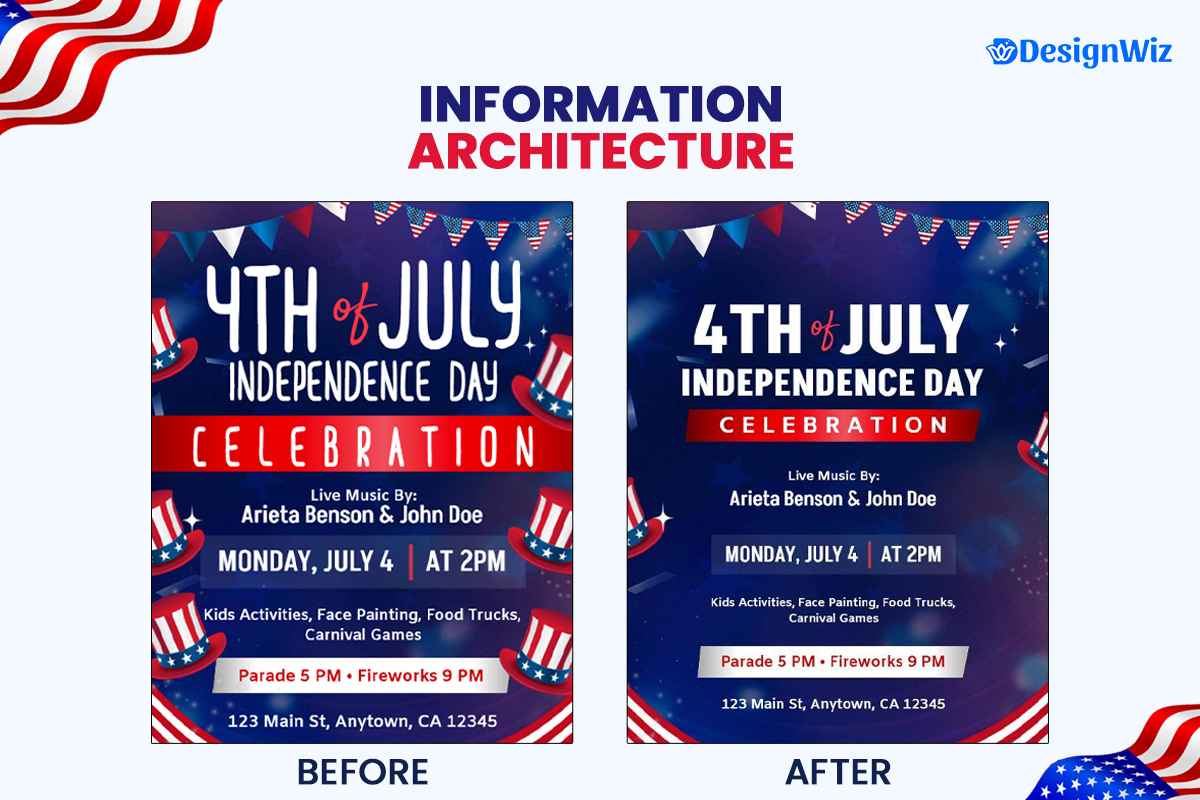
For more guidance on general visual organization, see our typography guide for 4th of July flyers.
What Distribution Strategies Maximize Event Attendance?
To maximize event attendance, focus on targeted distribution strategies for community event flyers. Distribute flyers in locations where your audience is most likely to be, such as local businesses, community centers, and schools. Personalize your outreach to specific neighborhoods and groups to increase relevance and engagement, leading to higher attendance.
Community-Specific Distribution Locations
Effective locations for 4th of July community event flyers include:
| Location Type | Effectiveness | Best Practices | Target Audience |
|---|---|---|---|
| Community Centers | ★★★★★ | Central bulletin boards, activity areas | Families, seniors, and community-engaged |
| Libraries | ★★★★☆ | Information boards, children’s areas | Families, diverse age groups |
| Schools | ★★★★☆ | End-of-year materials, summer program info | Families with children |
| Local Businesses | ★★★★☆ | High-traffic retailers, service providers | General community |
| Municipal Buildings | ★★★★★ | City hall, government offices, park buildings | Civic-minded residents |
| Religious Organizations | ★★★★☆ | Bulletin boards, community announcements | Family-oriented, community members |
| Farmers Markets | ★★★★☆ | Information booths, community tables | Local-focused residents |
According to a study on community-based participatory research, involving community members in the planning and execution of distribution strategies can enhance the effectiveness of outreach efforts by ensuring that materials are disseminated through trusted and accessible channels. The study found that community-led outreach initiatives increased engagement and response rates by as much as 45% compared to top-down distribution methods.3
Digital-Physical Integration
Modern event promotion requires a coordinated digital-physical strategy:
- QR Code Integration: Link to event registration, maps, or additional information
- Social Media Coordination: Create shareable digital versions of physical flyers
- Email Distribution: Send digital versions to community lists and prior attendees
- Community Group Posting: Share in neighborhood apps and community groups
- Event Calendar Submissions: Submit to local media and community calendars
Timing Strategy for Maximum Impact
4th of July events have specific timing considerations:
- Initial Awareness: First distribution 3-4 weeks before the event
- Primary Promotion: Heavy distribution 2 weeks before
- Final Push: Reminder distribution 3-5 days before
- Day-Before Visibility: Digital reminders 24-48 hours before
Volunteer-Powered Distribution
Leverage community volunteers for wider reach:
- Create distribution kits with defined routes and locations
- Provide clear instructions for posting guidelines and permissions
- Track distribution coverage to ensure community-wide visibility
- Target specific neighborhoods based on past attendance patterns
- Engage youth groups and community organizations in the distribution
Case Study: How CityFest Increased Attendance by 62%
The annual CityFest 4th of July Celebration faced declining attendance despite consistent programming. By revamping their flyer design and distribution strategy, they achieved remarkable results that demonstrate the principles outlined in this guide.
Challenge
CityFest organizers identified several issues with their previous approach:
- Generic event information without specific activity details
- Poor schedule presentation that created confusion
- No map or clear location guidance
- Cluttered sponsor recognition that dominated the design
- Limited distribution focused primarily on municipal buildings
Solution
Working with community event specialists EventSuccess, CityFest implemented a comprehensive strategy:
- Information Architecture Overhaul
- Created a clear information hierarchy with essential details prominent
- Developed a detailed activity schedule with time-based formatting
- Designed an intuitive event map showing activities, parking, and facilities
- Reorganized sponsor recognition into a structured, visually balanced format
- Visual Design Enhancement
- Implemented color-coding for different activity zones
- Used a consistent typography system with proper hierarchy
- Created visual balance while maintaining information density
- Incorporated engaging community photography from previous years
- Strategic Distribution
- Expanded to 35+ community distribution points
- Engaged a volunteer team to cover residential neighborhoods
- Implemented digital distribution across community platforms
- Created a graduated distribution timeline (3 weeks, 2 weeks, 3 days before)
- Multi-Format Approach
- Developed comprehensive 8.5″ x 11″ full detail flyers
- Created simplified 5.5″ x 8.5″ versions for wider distribution
- Added QR codes linking to online event information
- Designed social media-optimized graphics from the same visual system
Results
CityFest’s revamped approach delivered exceptional results:
- 62% increase in overall attendance
- 87% increase in family attendance
- 94% of attendees reported finding the information “very clear.”
- 73% higher sponsor satisfaction ratings
- 118% increase in social media sharing of event information
Community Event 4th of July Flyer Templates
Our community event-specific 4th of July flyer templates incorporate all the best practices discussed in this guide. Each template is fully customizable to your specific event details, activities, and community needs.
Featured Community Event Templates
Our templates include specialized designs for:
- Main community celebrations
- Parades and processions
- Fireworks displays
- Community festivals and fairs
- Patriotic ceremonies
- Family-focused events
Each template includes:
- Information hierarchy optimized for event details
- Schedule presentation formats
- Map and location elements
- Sponsor recognition sections
- Activity highlighting areas
Ready to create community event flyers that drive 4th of July attendance? Explore our Community Event Flyer Templates.
4th of July Community Event Flyer Design Inspiration Gallery
Discover a handpicked collection of 4th of July community event flyer designs to inspire your next celebration. Each flyer links to a full preview page with easy customization options.
Main Community Celebration Flyers
- Town-Wide Independence Day Celebration Flyer
- 4th of July Community Freedom Festival and Fireworks Flyer
- 4th of July Day Wise Celebration Flyer
- Small-Town 4th of July Event Flyer
- Family-Focused Independence Celebration Flyer
- Neighborhood Block Party & Patriotic Celebration Flyer
Parade Announcement Flyers
- Independence Day Annual Parade Announcement Flyer
- 4th of July Community Parade Viewer’s Guide Flyer
- 4th of July Parade Participation Guide Flyer
- Children’s Patriotic Parade Announcement Flyer
- 4th of July Historic Main Street Parade Flyer
- Multi-Generational 4th of July Parade Event Flyer
Fireworks Display Announcement Flyers
- 4th of July Community Fireworks Spectacular Flyer
- 4th of July Lakefront Fireworks Display Flyer
- 4th of July City Fireworks Show Flyer
- 4th of July Family-Friendly Fireworks Event Flyer
- 4th of July Multi-Location Fireworks Display Flyer
- 4th of July County Fairgrounds Fireworks Celebration Flyer
Patriotic Festival/Fair Flyers
- 4th of July Festival and Street Fair Flyer
- 4th of July All-American County Fair Event Flyer
- 4th of July Patriotic Arts and Crafts Festival Flyer
- 4th of July Freedom Festival Food and Music Event Flyer
- 4th of July Stars and Stripes Community Fair Flyer
- 4th of July Red, White and Blue Heritage Festival Flyer
Fun Run/Sporting Event Flyers
- 4th of July Freedom 5K Run and Walk Flyer
- 4th of July Family Fun Run Flyer
- Independence Day Charity Sports Tournament Flyer
- 4th of July Stars and Stripes Triathlon Flyer
- 4th of July Old Glory Bike Parade and Ride Flyer
- 4th of July Red, White and Blue Community Field Day Flyer
Frequently Asked Questions
Including 5-7 specific activities with brief descriptions can boost attendance intent by 43%. If there are more than 10 activities, group them into categories and direct attendees to a website or separate program for full details. The key is to provide enough information while keeping it readable.
For a 4th of July community event, distribute initial flyers 3-4 weeks before, follow up 10-14 days prior, and send final reminders 3-5 days before. This approach ensures early planning and timely reminders. Research shows that promoting less than 10 days before the event can reduce attendance by 18%, as families often have other plans.
Instead of separate flyers, use visual organization to distinguish age-appropriate activities within your main flyer. Research shows that flyers with clear age designations perform 37% better, as families can plan their entire experience. Consider using color-coding or icons to indicate age ranges (e.g., “All Ages,” “Ages 5-12,” “Teen,” “Adult”) and group family-friendly activities together.
The best approach is to create a dedicated sponsor section with a clear visual hierarchy based on contribution level. Recognizing sponsors with proportional logo sizes boosts satisfaction by 43%. For events with many sponsors, list top-tier sponsors and include text like “and 25 more sponsors” with a QR code linking to the full list.
Maps are essential for community events, especially in parks or places without street addresses. Even at familiar venues, include a simple map with entry points, parking, and key activity areas. For multi-location events, maps help attendees plan and navigate, boosting first-time attendance by up to 31%.
Conclusion: Creating Community Event Flyers That Drive Participation
Effective 4th of July community event flyers balance comprehensive information with visual appeal to maximize attendance and participation. By implementing event-specific information hierarchies, schedule presentation, mapping elements, and distribution strategies, your community celebration can achieve significantly higher attendance and engagement.
Remember these key community event principles:
- Provide comprehensive, well-organized information that helps attendees plan
- Create clear schedule presentations that highlight key activities
- Include maps and location details to remove attendance barriers
- Implement strategic community-focused distribution
- Tailor your approach to your specific event type
Reference
- “4th of July Community Celebration”. last updated on February 19, 2025. Retrieved April 25, 2025. City of Santa Clara’s official 4th of July event page.
- “Best Practices for Designing Flyers.” Retrieved April 28, 2025. Northwestern University.
- “Community-based participatory research (CBPR)” Archived from the original on Jan 22, 2018 . Retrieved April 28, 2025. Collins, S. E., Clifasefi, S. L., Stanton, J., et al.
